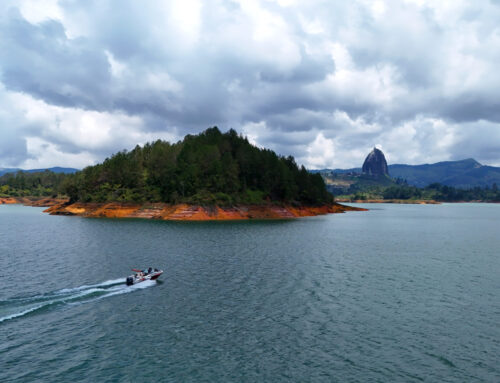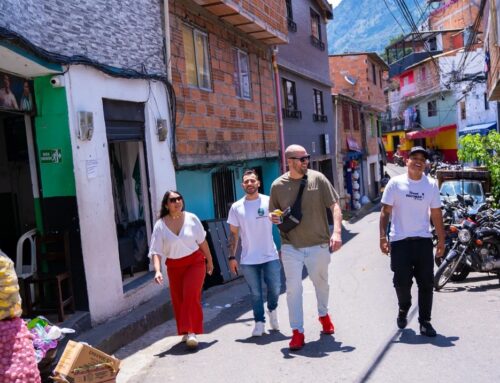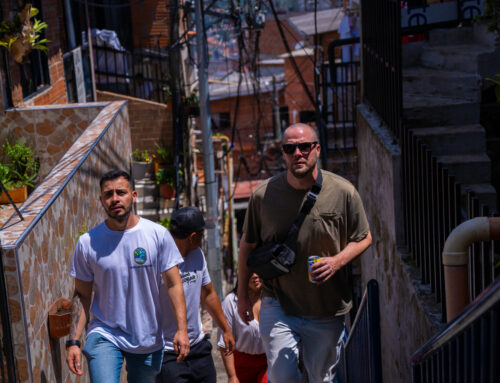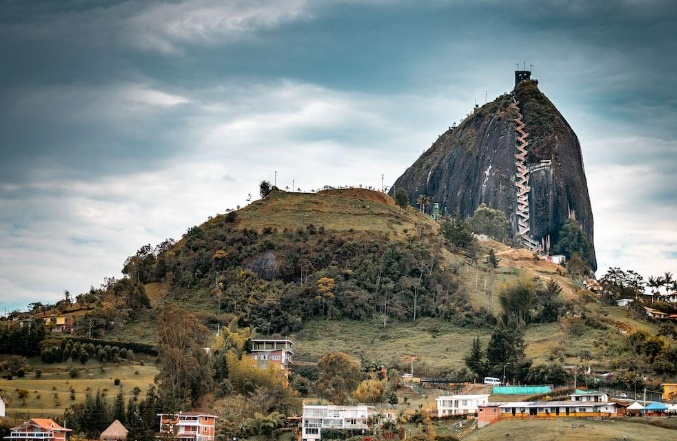
There are many historical highlights to be seen around Medellin, but most of them aren’t 65 million years old. That’s the case with El Peñón de Guatape, or the Piedra del Peñol. This massive rock outcropping can be found near Guatape, and is popular with tourists from all over the world. What about before it became the prime attraction for Guatape tours, though? El Peñón de Guatape has a storied history from well before it was “discovered” by the outside world, which makes present-day visits all the more interesting.
Historical background of El Peñón de Guatape
The rock has stood for millions of years, and most of what we know about it comes from much more recent times. Even though we aren’t exactly sure how it came to be, it’s likely that El Peñón de Guatape was simply better able to resist erosion compared to the rest of the Antioquia Batholith, of which it forms a part. While the rest of the granite formation slowly fragmented and wore down over the millennia, this part of it remained whole.
Before modern-day Colombians inhabited the Antioquia region, it was home to the Tahami, an indigenous people group who viewed the rock as an object of worship. It may not be worshipped anymore, but it was declared a National Monument in the 1940s.
Even though the rock was very likely scaled at some point before then, 1954 was when the first “official” trip to the top took place. This was done by Ramón Díaz, Pedro Nel Ramírez, and Luis Eduardo Villegas López, who climbed with the help of sticks that had been wedged into the fissure that runs lengthwise up the face of the rock. The adventure took five days in total, and marked the beginning of the interest in making this landmark more accessible. Since El Peñón de Guatape couldn’t be used for farming, locals had no interest in holding onto it; they sold it to López, who quickly built permanent stairs to the top, and started charging visitors for the unique experience of climbing this impressive rock.
Book a Tour of El Peñón & Guatape
Disclosure: Some links on Medellin-Tours.com may earn us affiliate commission, at no cost to you. Affiliate links are a way for us to earn a commission if you purchase a tour we recommend through Viator for another provider.
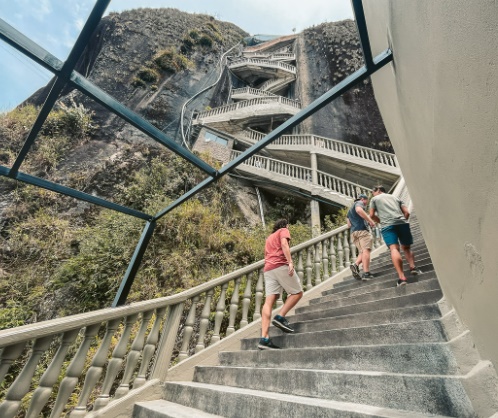
Going up the stairs of El Peñón de Guatapé
The construction of the stairs for Guatape tours
One of El Peñón de Guatape’s main characteristics is a vertical crevasse that runs the length of its tallest side. For the 1954 climb, the group of friends wedged sticks into the crack at short intervals to form a kind of ladder. Tourists taking Guatape tours still follow the exact same route, but much less precariously. This is thanks to the construction of a staircase, which zig-zags the 650-foot rock all the way to the top. There are 715 stairs in total, plus a 3-story lookout tower if climbers feel like taking a few steps more for an even better view.
Speaking of views, it’s worth mentioning what hundreds of thousands of tourists see every year when they scale El Peñón de Guatape. Most 360-degree views are pretty impressive at 650 feet, but this rock formation is located at the edge of Lake Guatape. This lake was formed in the 70s, when the Colombian government decided to flood the valley. Now it’s a picturesque part of the view, made even more beautiful thanks to the countless islands that dot the lake.
The initial ascent of El Peñón de Guatape in 1954 by Ramón Díaz, Pedro Nel Ramírez, and Luis Eduardo Villegas López was a daring feat. The rock’s sheer face, with its vertical crevasse, presented a formidable challenge. The trio had to rely on their ingenuity and physical prowess to overcome the obstacles.
They devised a method using sticks wedged into the fissure to create a makeshift ladder. This innovative approach allowed them to gradually ascend the rock, though the process was slow and precarious. The climb took five days in total, a testament to their determination and the difficulty of the task.
While the initial ascent was a personal endeavor, the construction of the permanent stairs involved significant local participation. The community of Guatape recognized the potential of El Peñón de Guatape as a tourist attraction and rallied behind the project.
Local residents provided labor, materials, and expertise to help build the staircase. Their contributions were essential in transforming the once-inaccessible rock into a popular destination. The community’s involvement not only facilitated the construction but also fostered a sense of ownership and pride in the landmark.
Ownership controversy
Even though nobody disputes who legally owns El Peñón de Guatape, the neighboring towns of Guatape and El Peñol have been arguing about which town the rock belongs to for years. Even the name isn’t agreed upon; residents of Guatape call it “El Peñón de Guatape”, but residents of El Peñol call it “La Piedra del Peñol”.
There was actually an attempt by a Guatape resident to claim the rock for the town, by marking it with a gigantic graffiti spelling out GUATAPE on the rock’s western face. However, the enterprising painter only completed the G and part of the U before a crowd of protestors from El Peñol gathered and put a stop to it.
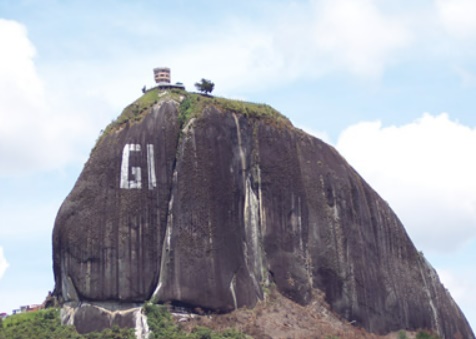
El Peñón de Guatapé with the “G” and part of the “U” before the painter was forced to quit!
Despite the ongoing dispute, there have been efforts to find a resolution. Mediation and negotiation have been explored as potential avenues to resolve the ownership claims.
Local leaders and community representatives have engaged in discussions to find a mutually agreeable solution. However, the deep-seated emotions and competing interests involved have made it challenging to reach a consensus. The ownership controversy remains a complex issue that requires careful consideration and compromise from all parties involved.
Book a Tour of El Peñón & Guatape
Disclosure: Some links on Medellin-Tours.com may earn us affiliate commission, at no cost to you. Affiliate links are a way for us to earn a commission if you purchase a tour we recommend through Viator for another provider.
Tourism at El Peñón de Guatape
Given how popular this destination is for tourists, it’s no surprise that the stairs to the top are dotted with vendors of all types. This works out well for everyone involved, though; with over 700 stairs to climb, many people are happy to purchase refreshing beverages and local foods along the way. At the top of the rock, there’s even a bar where visitors can purchase beers to drink while they take in the views. And of course, the souvenir vendors don’t get left out either! From handmade items to postcards, these vendors are located along the stairs and at the top.
It’s certainly a demanding physical endeavor, but that doesn’t seem to discourage many people from the climb. That being said, there are plans to construct a cable car system that will effortlessly take people to the top. This will likely make the spot even more popular, and make it accessible for those with physical disabilities.
Even though El Peñón de Guatape is an iconic landmark in the area, and the nearby towns of Guatape and El Peñol are fun to visit, many visitors are actually tourists that come from Medellin. This is because both of the neighboring towns are quite small, and the rock itself takes just a couple of hours to climb. However, Medellin has enough to keep tourists busy for days, and it’s within easy driving distance of El Peñón de Guatape. Because this rock is still a must-see tourist hotspot, though, many tourists in Medellin decide to book a Guatape tour at some point, rather than planning a multi-day trip to the area.
El Peñón de Guatape has a rich history that deserves recognition
Even without knowing the background of this impressive rock formation, it’s still both imposing and memorable. However, visitors who join Guatape tours or do their own research will have an even deeper enjoyment of the experience. After all, it makes sense that this 65-million-year-old rock was once worshipped, just like it now makes sense that it was turned into a popular tourist destination. By learning about the past and the present of El Peñón de Guatape, visitors can help keep them both alive.
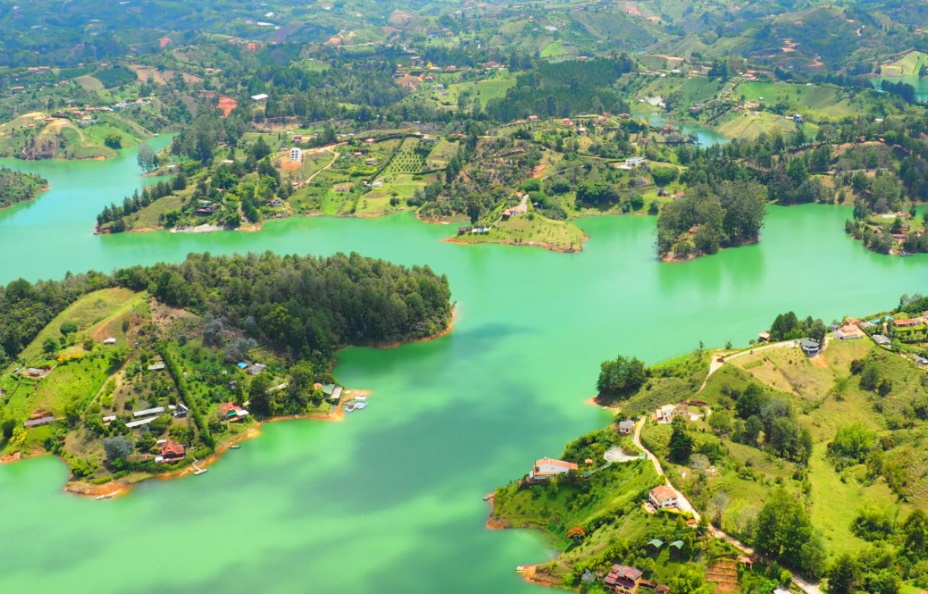
Guatape Lake
Environmental Impact of Tourism
El Peñón de Guatape’s increasing popularity as a tourist destination has raised concerns about its environmental impact. To mitigate these concerns, various sustainable practices and initiatives have been implemented.
One such initiative is the promotion of responsible tourism. Visitors are encouraged to follow guidelines such as avoiding littering, respecting the natural environment, and minimizing their carbon footprint. Educational campaigns and signage are used to raise awareness among tourists and local communities about the importance of environmental conservation.
Additionally, efforts have been made to reduce the consumption of plastic and promote the use of reusable items. This includes providing water refill stations and encouraging visitors to bring their own reusable bottles and bags. Furthermore, local businesses are being encouraged to adopt sustainable practices, such as using eco-friendly products and reducing waste.
Conservation Efforts
To protect the natural environment around El Peñón de Guatape, several conservation efforts have been undertaken. These include:
- Reforestation: Reforestation programs have been implemented to restore degraded areas and increase the forest cover surrounding the rock. This helps to protect biodiversity and prevent soil erosion.
- Wildlife Conservation: Efforts are being made to monitor and protect wildlife species that inhabit the area. This includes the creation of wildlife corridors and the implementation of measures to prevent habitat fragmentation.
- Water Quality Management: Measures are being taken to protect the water quality of the surrounding lakes and rivers. This involves monitoring water pollution levels and implementing measures to reduce pollution from human activities.
- Waste Management: Proper waste management practices are being implemented to prevent pollution and protect the environment. This includes the collection and disposal of waste in an environmentally responsible manner.
By adopting sustainable practices and implementing conservation efforts, El Peñón de Guatape can continue to be a popular tourist destination while minimizing its negative impact on the environment. These initiatives contribute to the preservation of the natural beauty of the area for future generations to enjoy.
Book a Tour of El Peñón & Guatape
Disclosure: Some links on Medellin Tours may earn us affiliate commission, at no cost to you. Affiliate links are a way for us to earn a commission if you purchase a tour we recommend through Viator for another provider.

